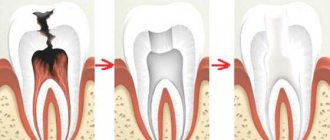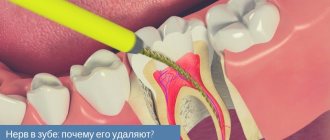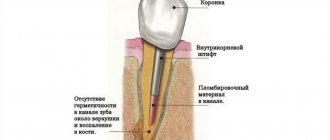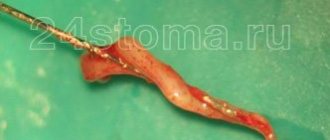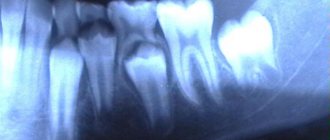The vitality of the tooth, in particular its sensitivity, is ensured by the neurovascular bundle (pulp). Removal of the pulp (depulpation) is a forced measure, which is resorted to for serious indications (pulpitis, hilar cyst, damage to the pulp chamber due to trauma, etc.). Painful discomfort for several days after depulpation is a normal tissue reaction to the intervention. But if a tooth hurts after removing the nerve and filling the canals after 2-3 weeks
or pain occurs suddenly long after endodontic treatment, this is a good reason to see a dentist.
Even treated teeth should be examined every year to diagnose or rule out complications at an early stage. A pulpless tooth does not hurt, but it is like a time bomb. Poor-quality canal treatment can provoke complications that destroy the jaw bone and cause purulent processes (cysts, abscesses) that are life-threatening. Properly treated canals are the foundation of any restoration. The more modern and high-quality the materials used for their processing, the less likely there are complications.
Indications for nerve removal
- Caries has reached the pulp. Initially, caries appears on the enamel, then moves to dentin, then to the pulp. Inflammation increases: acute pain occurs. To eliminate the pain and save the tooth, you need to remove the nerve.
- Injuries of various types: impact, fracture, chip. With such mechanical impact, traumatic pulpitis develops. The integrity of the tooth is damaged, the infection penetrates into the pulp. Inflammation occurs and pain appears. Treatment involves removing the nerve.
- Retrograde infection. When inflammation occurs at the apex of the tooth root, it then spreads to the nerve.
- Orthopedic treatment. Before placing a crown, in some clinical cases it is necessary to remove the nerves. To avoid complications, a severely damaged tooth is first treated: the nerves are removed.
- Asymptomatic pulpitis (chronic). The patient does not have acute pain, but the nerve is infected. The patient's complaints may include mild pain in the past.
What complications may arise?
Pain syndrome is a protective reaction of the body in response to tissue damage or inflammation. It is also one of the main symptoms of developing pathological changes. If you ignore the problem, you may encounter a deterioration in your overall health and serious illnesses: sepsis, phlegmon, amyloidosis.
- Local suppuration in the area of the affected tooth can spread to nearby periodontal and periodontal tissues, and then, with the bloodstream throughout the body. The situation is developing rapidly; people with chronic periodontal diseases are at high risk
- Inflammation of the periosteum is characteristic of suppuration of remnants of nerve fibers. The pathology is manifested by the formation of a cyst or granuloma, high body temperature, shooting pain radiating to the ear, eye and temporal region
A timely visit to the dentist significantly increases the chances of saving the tooth. The doctor will re-treat the root canals, after which he will fill them with medicinal paste or insert a turunda soaked in an anti-inflammatory solution. After 7-10 days, the canals are closed with a permanent filling. In advanced situations, a decision is usually made to remove the unit
What are the methods for removing a nerve?
- Amputation . This method is rarely used: mainly in pediatric dentistry. Its essence lies in the fact that the neurovascular bundle is partially removed. The pulp remains in the roots, and only the coronal part is removed. In adults, it is used in exceptional cases, when the doctor sees that the inflammation has affected only a small part of the nerve.
- Extirpation . The pulp is completely removed from the tooth. After removing the nerve, the canals are cleaned, washed, and filled.
When is depulpation prescribed?
An intervention of this kind is necessary when it is necessary to stop pathological processes in the soft tissues of the tooth. Indications for the procedure are:
- sharp pain followed by prolonged aching pain;
- caries, which destroyed the protective tissues of the tooth and caused inflammatory processes in the pulp;
- pulpitis, requiring complete or partial removal of the pulp;
- periodontitis;
- mechanical damage to the tooth, which resulted in exposure of the neurovascular bundle;
- prosthetics;
- dental defects;
- there is excessive tooth wear;
Before carrying out the depulpation procedure, the specialist must conduct a visual and instrumental examination of the patient. After collecting an anamnesis, taking into account the analysis of x-rays, the doctor determines the feasibility of the manipulation.
Important: Sometimes before depulping, professional teeth cleaning is carried out: removing plaque and tartar. Manipulations are recommended if without them it is not possible to obtain a long-term result.
Prosthetics after tooth depulpation
After removing the tissues that fill the tooth cavity, containing blood vessels and nerves, the tooth is considered “dead.” He becomes vulnerable and brittle. To prevent the destruction of the dental element in the future, the doctor recommends installing a crown on it after depulping the tooth. When filling, the pulp is replaced with a composite material. The sealed element of the dentition, along with other teeth, participates in the processes of chewing food and is subjected to significant loads. To prevent staining of the filling, it is covered with a crown.
Depulpation of teeth during prosthetics
But there is also the exact opposite process. If the patient wishes to install a permanent denture, the specialist must examine the teeth that will be involved in the procedure. In some cases, the dentist prescribes pulpotomy of all or some elements of the dentition:
- with increased tooth sensitivity;
- in case of deformation and incorrect positioning of the tooth in the row;
- with initial signs of pulpitis;
- for chronic caries.
Depulpation before prosthetics is carried out, since after installing a permanent prosthesis, it will be more difficult to treat the tooth; you will need to remove the bridge or crown, which is a traumatic factor. In addition, under the bridge, pathological processes can develop much faster and be more widespread.
Whitening of pulpless teeth
After pulp removal, teeth become susceptible to external factors. They can quickly lose their aesthetic appeal as they darken. In this case, a color restoration procedure is recommended. It is called “endobleaching”. The essence of the manipulation is the introduction of a lightening substance into the tooth. Endobleaching is performed without pain.
Indications for tooth whitening after pulp removal are:
- filling with a coloring composition;
- darkening of dentin under the influence of dyes: tea, coffee, nicotine.
Endo-stripping involves removing the filling and cleaning the composite material from colored particles. Bleach is injected into the existing cavity, and the tooth cavity is covered with a temporary filling that will last two weeks.
When you visit the dentist again, the temporary filling and coloring material are removed. The tooth is restored with special materials. The recommended frequency is once a year.
Consequences of tooth depulpation
Sometimes after removal of the nerve, the patient feels pain in the tooth, and swelling of the gums is observed. Reaction to cold and hot food or mechanical stress can be caused by:
- the body's reflex to remove the pulp;
- poorly performed depulpation procedure;
- the presence of nerves that were not removed;
- using unsuitable filling material;
- inflammation of the gums caused by tissue trauma during treatment;
- the presence of pathological processes in the adjacent element of the dentition, when the pain radiates to the “dead” tooth.
Only a specialist can determine the cause of the pain. If the pain is caused by inflammatory processes, a specialist may prescribe antibiotics. If the sensations are caused by a poor-quality depulpation procedure, it is necessary to re-open the canals, clean them, and restore the tooth with a composite. If you ignore prolonged painful sensations, a gumboil, fistula or cyst may develop.
Tooth removal: contraindications
Dental pulpotomy is not performed for the following diagnoses and conditions:
- acute leukemia;
- chronic heart disease;
- pregnancy;
- infectious hepatitis;
- stomatitis in acute or chronic stages;
- hemorrhagic diathesis;
- inflammatory diseases of the oral cavity and upper respiratory tract.
If there are contraindications to pulp removal, the dentist should offer an alternative treatment method.
How long will a tooth last after pulpotomy?
It is important to understand that the resource of a pulpless tooth may vary from patient to patient. Even in one person, two different teeth after depulpation can “behave” differently.
If the procedure is carried out in compliance with the protocol, the canals are thoroughly cleaned, their sealing is achieved, and pathological tissue is completely removed, the tooth can last several decades. The service life of a tooth after pulpotomy increases significantly if a high-quality and reliable crown is installed on it.
How to avoid tooth depulpation?
If pathological processes are already running, it will not be possible to avoid the procedure. If left untreated, the tooth will be lost. It is possible to exclude depulpation only if the occurrence of pathological processes is prevented. In this case, prevention is the best ally.
Careful care of the oral cavity with well-chosen products, a nutritious and balanced diet, and regular visits to the dentist will help keep the elements of the dentition healthy and prevent the development of caries and other pathologies.
Sequence of treatment
- Diagnostics . After the doctor has examined you and collected your medical history, an X-ray is taken. This diagnosis allows you to evaluate the structure of the tooth and plan treatment. To see the full anatomy of the root canals, a computed tomography (CT) scan is performed - a 3D diagnostic that allows you to see all the structures of the tooth.
- Pain relief . Local infiltration or conduction anesthesia is performed. Before the injection, the gums are lubricated with an anesthetic gel so that the injection is not felt.
- Setting up insulation . Root canal work should be done in clean, dry conditions. For this purpose, rubber dam (insulation) is used. It is a latex plate that is placed on the tooth. Advantages of isolation: saliva and plaque do not enter the root canals. Medicines and solutions also do not flow into the patient’s mouth.
- Preparation of hard dental tissues . The doctor uses a drill to remove the destroyed tissue. To prevent overheating of the tooth, water flows from the tip. The doctor creates direct access to the root canals.
- Nerve removal . It is performed with thin sterile instruments similar to long needles. The doctor places an instrument into the root canal and removes the nerve. Machine rotary tools may also be used. This stage is completely painless, since anesthesia was previously performed.
- Mechanical and medicinal treatment of canals . The canals are washed with special antiseptic solutions and passed through with instruments. This allows you to completely remove the diseased nerve and relieve inflammation.
- Temporary filling . Root canal work is complex, so it is not always possible to treat a tooth in one visit. An anti-inflammatory paste is placed into the canals, a temporary filling is placed, and a further stage of treatment is planned.
For permanent restoration of the crown part of the tooth, ]esthetic dentistry[/anchor] will be required.
How to fix the problem
The treatment method is determined by the cause of the inflammatory process and pain. Depending on this, the following ways to resolve the problem are possible:
- For trigeminal neuralgia, anticonvulsants and antispasmodics are prescribed.
- If the nerve is not completely removed, depulpation is performed again.
- If there is an allergy or perforation of the tooth roots, a new filling is installed. The integrity of tissues is restored with the help of modern medications.
- If there is a purulent formation (periodontitis), it is opened, cleaned and treated with antiseptics.
If a piece of instrument is found in the canal, it should be removed as quickly as possible. To do this, the doctor must have sufficient experience and knowledge.
Contraindications
Doctors at the SDent aesthetic dentistry center collect all data about the patient’s condition before starting treatment. In the health questionnaire, the patient notes the characteristics of his body, and the doctor conducts a survey. Planned nerve removal is not performed if:
- high blood pressure, hypertensive crisis;
- first, third trimester of pregnancy (provided there is no acute pain);
- acute inflammatory diseases of the mucous membranes and facial skin;
- acute respiratory and viral diseases, etc.
The main causes of pain immediately after depulpation
A feeling of mild pain in a pulpless tooth is acceptable for two to three days after the intervention. A natural reaction is increased sensitivity to temperature stimuli. Such symptoms are caused by traumatization of mucosal tissues and nerve fibers, as well as the formation of a hematoma (local hemorrhage).
Dentists identify several main causes of pain immediately after depulpation:
- Contact of filling material with gum tissue. The situation occurs frequently and occurs due to incorrect determination of the channel length or excessive pressure when feeding the composite.
- During treatment, the doctor uses very thin needles. Despite their strength, when passing curved areas, there is a high probability that a fragment of the tool may break off.
- Allergic reaction of the patient's body to the composite. The condition is dangerous for people seeking dental care for the first time. In this case, the pain syndrome is accompanied by swelling and redness of the oral mucosa, an increase in body temperature, and urticaria and itching are characteristic.
If the pain increases or occurs suddenly a few days after surgery, then this is an obvious reason to visit a doctor.
General recommendations after treatment
- You can eat and drink immediately after treatment;
- Until the anesthesia wears off, you should not eat rough food;
- in the days following treatment on the side of the diseased tooth, do not chew rough, hard food;
- in some cases, anti-inflammatory drugs, painkillers, and oral baths are prescribed;
- If a temporary filling falls out, consult a doctor immediately;
- If pain occurs after placing a temporary filling, also consult a doctor immediately.
After the anesthesia wears off, the patient may feel discomfort in the area of the treated tooth. If pain, throbbing, or swelling occurs, you should consult a dentist.
How to relieve pain
If a tooth hurts severely after treatment of pulpitis, taking a pain reliever (Analgin, Ibuprofen, Ketolac, etc.), rinsing the mouth with an antiseptic solution or a warm herbal decoction of lemon balm, sage, oak bark, chamomile, will help temporarily relieve the pain symptom and alleviate the condition. calendula.
It is strictly forbidden to heat a sore tooth, apply alcohol or garlic compresses to the gums, or take antibiotics or aspirin.
Long-term consequences after treatment
Patients often experience complications after nerve removal. This is due to many factors: lack of diagnosis, poor quality treatment, incorrect diagnosis, etc. Main consequences:
- poor canal filling. A loose filling leads to the re-emergence of bacteria that extend beyond the tooth root. A cyst forms, due to which the tooth is often removed;
- tool fragments. The complex anatomy of the canals and low-quality instruments can lead to its failure.
- removal of material beyond the root apex. If the filling material is chosen incorrectly or there is too much of it, it extends beyond the root.
- Tooth perforation occurs due to aggressive processing.
To avoid such complications, doctors at the SDent clinic recommend contacting us for medical help, as we have a staff of highly qualified doctors, an equipped X-ray room and advanced equipment!
How are teeth treated under a crown?
An example is the inflammatory process in the apical (deepest) part of the root canal. In case of poor preparation, the canal may not be sealed to its full depth, which leads to the development of infection. To avoid removing the crown, resection of the apical part of the root is performed. The procedure is performed by a dental surgeon and takes from 30 to 60 minutes.
The doctor drills a small hole in the bone tissue. Through it, he cuts off the poorly sealed tip from the root and removes the purulent sac. It should be noted that this method is characterized by minimal trauma. In addition, the procedure is performed under anesthesia, so the patient does not experience pain or discomfort. After removing a section of the root, the remaining part is carefully “sealed” with a special material for further isolation from microbes.
It is important to understand that it is not always possible to do without crown removal. The final decision on the method of treatment is made by the doctor, who may prescribe an X-ray examination to clarify the cause of inflammation. This is due to the fact that additional root canals or suspected cracks require mandatory removal of the structure.
Doctors providing this service
Tooth extraction is an extremely painful undertaking that causes a great deal of stress for most people. When the operation has already been performed, you can breathe more freely - all that remains is to follow fairly simple recommendations during the recovery period. After tooth extraction, a swollen and sharply painful wound remains in the mouth for some time, which interferes with eating. The timing of its healing depends on the general condition of the body, but the average period is considered to be 2-3 weeks. If a single-rooted tooth was removed, the hole heals in about 16 days, and if it is multi-rooted, it takes about 22 days. In addition, the length of the postoperative period depends on several other factors, for example, a young body heals such damage faster.
Oral care after tooth extraction
In the first two weeks, it is better not to brush your teeth at all, as this may resume bleeding and disrupt the entire healing process. Instead of brushing, you can rinse your mouth with hot water and clean your teeth with your finger until a characteristic squeak occurs. After this, be sure to rinse your mouth with special disinfectant solutions prescribed by your doctor. It should be borne in mind that frequent (more than three times a day) rinsing your mouth only slows down the healing process.
If the tooth was removed during the acute stage of the inflammatory process, then the healing of the hole takes longer and is much more painful. In this case, the doctor may prescribe oral or local use of anti-inflammatory drugs. Antibiotic mouth rinses should be alternated periodically to prevent bacteria from becoming accustomed to a particular drug. Lubricating the hole with the juice of the medicinal plant Kalanchoe works well - it gives a very strong analgesic and healing effect - often the wound heals within a few days. To increase biological activity, a plucked Kalanchoe leaf can be kept for 5 days on the bottom shelf of the refrigerator, preventing it from freezing.
How long can your gums hurt after tooth extraction?
Severe pain that interferes with normal life activities lasts no more than 3 days after the surgical procedure. It will take up to 7 days for the discomfort to disappear completely. For complex removal, this period increases to 2 weeks.
If during the rehabilitation period you feel pulsation in the socket, bleeding, or bad breath, then you need to contact a surgeon at the Cerekon clinic as soon as possible, because all these signs signal the development of inflammation.
